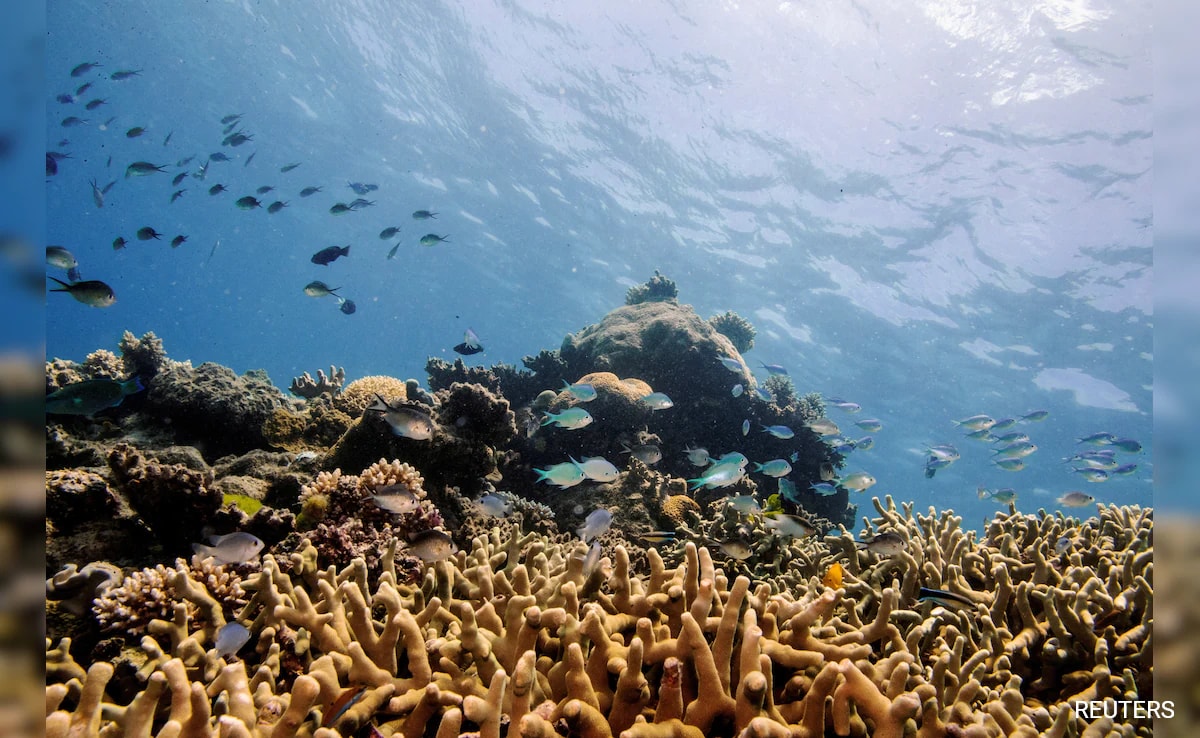SYDNEY:
An “unprecedented” mass bleaching event has hit Australia’s west coast, scientists announced on Wednesday, leaving large tracts of the renowned Ningaloo Reef system a dead white.
A long-lasting marine heatwave of more than a month has “cooked” the reef, oceanographer Kate Quigley said. Ningaloo, within a UNESCO World Heritage-listed marine park renowned for its colorful corals and whale shark migrations each year, now suffers from extreme bleaching.
While officials are still determining the full extent of damage, initial data collected by Quigley and a group of researchers indicate that this may be the worst mass bleaching episode in recent times for the reef.
“Warm ocean waters just cooked the corals this year,” Quigley told AFP in an interview.
“The use of the word ‘unprecedented’ actually applies here,” she said. “This time, it’s not only the surface corals, but bleaching has extended to deeper parts of the reef and is impacting numerous coral species.”
This is one of the ongoing fourth global coral bleaching crises, which started in 2023.
Global Impact on Reefs
US National Oceanic and Atmospheric Administration (NOAA) scientist Derek Manzello documented that between January 2023 and March 2025, 83.6 percent of the world’s coral reef systems have suffered bleaching-level heat stress, impacting 81 nations or territories.
“The bleaching in Western Australia is especially concerning based on initial reports,” Manzello explained. “The intensity of the heat stress experienced by these reefs is alarming.”
Not a Death Sentence, Yet
Stretching 300 kilometers (185 miles) across Australia’s west coast, Ningaloo Reef is the world’s largest fringing reef system. The most serious bleaching episode the reef has suffered since 2011 is the ongoing bleaching event, Quigley said.
Ocean temperatures across Western Australia were around three degrees Celsius above normal, the government weather bureau has reported. Temperatures above average were higher than the “bleaching threshold” mid-January, according to NOAA monitoring.
Bleaching happens when warmer waters prompt corals to expel the vibrant algae that reside in their tissues, turning the corals white and weakening them.
“Bleaching is an illness, but it does not necessarily lead to death,” Quigley said. “But if the damage is great enough, a lot of corals will not survive.”
Global Warming’s Toll on Reefs
Small bleached patches of coral were also seen on the northern end of the more well-known Great Barrier Reef along Australia’s eastern coast. Still, Quigley said that Ningaloo Reef and the Great Barrier Reef are influenced by distinct climatic systems, and it’s unlikely that both would bleached at the same time.
“The degree of ocean warming has grown so intense that it’s dominating local climate patterns,” said Quigley. “It’s astounding. When you examine it in terms of a national picture, the situation is very alarming.”
The Great Barrier Reef, also a UNESCO World Heritage Site and a popular tourist attraction, has already had five mass bleaching events over the past eight years. Although sections of the reef are presently bleaching, it has not yet passed the threshold to constitute a mass bleaching event.
Global temperatures are projected to reach record highs in 2024, according to climate experts, with prolonged heatwaves affecting oceans around the world. A report from NOAA in October warned that nearly 80 percent of the world’s coral reefs are at risk of bleaching between 2023 and 2024.
A United Nations report in December 2024 emphasized that warming seas, pollution, and overfishing are threatening coral reefs worldwide, with climate change driving their deteriorating trends.
Australia on the Frontline of Climate Change
Australia is seeing some of the globe’s most extreme climate effects. Sea surface temperatures off Australia were on track to reach a new high in 2024, according to the Australian National University. In addition to warming oceans, the nation has also suffered from worsening bushfires, heatwaves, and droughts—climate issues scientists directly attribute to global warming.
In spite of these environmental struggles, Australia continues to be one of the largest exporters of minerals, gas, and coal, powering an economy historically based on fossil fuels. As temperatures across the globe rise, scientists report that the country’s vulnerable ecosystems, including its famous reefs, are at the epicenter of the climate emergency.
Efforts to conserve coral reefs around the globe are gaining momentum, with governments and international agencies clamoring for enhanced action to curtail climate change, lower pollution, and maintain marine biodiversity. However, if drastic global measures are not undertaken, scientists predict that coral reefs, among the most biodiverse ecosystems on the planet, might suffer irreparable harm in the next few decades.
